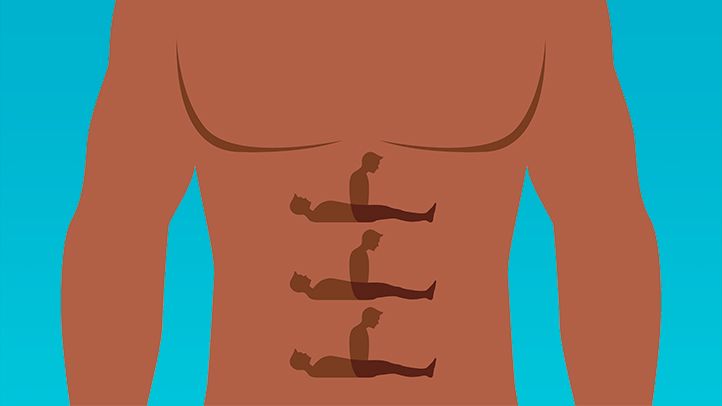How to get abs? It all boils down to genetics. And planks.
Six-pack abs are often held up as the pinnacle of fitness — if your middle shows those segmented muscles, you must be fit, right? Wrong.
Sure, it does take a lot of strength training to build up your abdominal muscles, but before you can understand everything that goes into sculpting a six-pack, you need to understand some basic anatomy. First: “The six-pack abs so many people chase are actually just one muscle, not six,” explains Melody Dickerson, a certified personal trainer and instructor at Fhitting Room, a high-intensity interval training (HIIT) studio in New York City.
What looks like six abdominals is actually just your rectus abdominis, adds Michele Olson, PhD, senior clinical professor of sport science at Huntingdon College in Montgomery, Alabama. “The rectus abdominis muscle has large tendons that stretch from right to left across the muscle,” Dr. Olson says. Those bands actually lay on top of the rectus abdominis, so “when the body fat in the belly area is reduced and the rectus abdominis muscle is developed, you see the muscle between each indentation,” she explains.
What Do You Have to Do to Get 6-Pack Abs?
If you want a more segmented look to your core, you’re going to need to build up your rectus abdominis. “Crunches are not going to get the job done,” says Dickerson.
Try These Advanced Abdominal Strengtheners
Dickerson suggests performing advanced supine (on your back) exercises, like jackknives; rotational (circular) movements, like oblique medicine ball slams; and suspended (from a hanging position) movements, like knee tucks and L-sits.
- Jackknives Lie flat on the floor on your back. Sit up, reach your right hand to your left toes, then lie back down. Alternate arms and legs.
- Oblique Medicine Ball Slams From a standing position, hold a medicine ball at one hip, then lift it overhead and pivot your body to slam it down on the floor on the other side. Repeat, alternating sides.
- Hanging Knee Tucks Hang from a bar with your arms overhead and tuck your knees up to your chest.
- Hanging L-Sits While hanging from a bar with your arms overhead, raise your legs straight out in front of your hips, making an L shape with your body.
Try to perform three rounds of each exercise for 30 to 45 seconds per round, Dickerson suggests.
Other suspended movements may be even more beneficial. According to one study, using a TRX suspension trainer for a roll-out exercise (stand at an incline while holding the TRX straps with your arms perpendicular to the floor, then flex your shoulders to move your hands forward) showed the highest activation of the rectus abdominis muscles. The body saw (with your feet in the TRX strap handle, form a plank or push-up position with your forearms touching the floor, then push your body backward) was also found to effectively activate the rectus abdominis muscles.
Pilates- and Yoga-Inspired Core Exercises
Pilates- and yoga-inspired moves can help, too. “Pilates exercises work the entire group of abdominal muscles, but I found in lab tests that the roll-up, the teaser, and the roll over were really bullish on the rectus abdominis,” says Olson. Here’s how to perform each of these three moves, according to Olson:
- Roll-Up Lie flat on the floor on your back, with your legs straight and your arms stretched out behind your head. Make sure your low back isn’t arching. Breathe in and begin rolling up through your spine, floating your arms up in the air. Breathe out as you roll up through your spine and press your ribs down. Stretch your arms and body forward. Breathe in and then breathe out as you roll back to the starting position.
- Teaser This exercise is often called a banana roll, for good reason. Lie flat on the floor on your back, with your legs straight and your arms stretched out behind your head. Make sure your low back isn’t arching. Breathe in and begin lifting your legs and rolling your shoulders off the floor. Breathe out and press your ribs down as your legs and upper body roll off the floor. Lift your arms and legs until they reach a 45-degree angle, with your arms parallel to your legs. Breathe out as you slowly roll back to the starting position.
- Roll Over Lie flat on the floor on your back, with your arms by your sides, palms down, and lift your legs to a 90-degree angle. Breathe in and begin to reach your legs over your head as your pelvis tilts backward. Keep your palms pressed down on the floor and end with your feet and legs parallel to the floor. Breathe out and slowly move your legs back to the 90-degree position, placing one vertebra at a time on the floor. Important: If you have any neck or back issues, talk to your doctor, trainer, or physical therapist before trying this exercise.
Hip-ups, for which you lie on your back with your feet extended toward the ceiling and use your lower abs to lift your hips off the floor, are also great for the abs, Olson adds.
Olson also recommends including yoga-inspired planks in your workouts, because they protect your spine while effectively strengthening your abs. According to a study, a long-lever posterior-tilt plank is especially good for developing your rectus abdominis. In this advanced variation on a traditional plank, your forearms are on the floor, your elbows are closer together and further toward your head than in a traditional plank, and you squeeze your glutes to tilt your pelvis back.
If you really want to see definition in your abs, you can do abdominal exercises five times a week, says Olson. “You’d want to do an ab sequence of five or so exercises” — look to the moves recommended above — “and do 12 reps of each before resting and repeating the sequence 3 to 5 times, finishing with some planking,” she recommends.
RELATED: Does Yoga Count as Exercise?
Aerobic Exercise Plays a Role, Too
But it’s not just about working your core muscles. “If you’re trying to lose the fat tissue under the skin that sits above the muscle, HIIT and cardio training are best,” explains Olson. But it needs to be intense. “You’ll want to push yourself into a zone that elevates your heart rate to at least 85 percent of your max. Do this after you’ve done a solid 20 minutes of challenging cardio, like running or Spinning. Then launch into 10 to 15 minutes of HIIT, skipping rope, doing plyometrics like squat jumps, or sprinting on a bike or treadmill,” she says.
Can Everyone Get Sculpted 6-Pack Abs?
The short answer: unfortunately, no. “Visible abs are very difficult to achieve for those of us who aren’t genetically blessed,” says Dickerson. “Everyone’s muscles are built differently. Some people have deep muscle bellies, which create higher peaks in between those tendons, and thus abs are more visible. Others have more shallow muscle bellies, which means you may never get the peaks and valleys like some people.”
The size and length of your tendons and the makeup of your muscle fibers affect your abs, too, and these are things you can’t change. “Some people have more fast-twitch muscle fibers, which are used for fast, powerful bursts, while others have more slow-twitch fibers, which help with endurance tasks,” says Olson. “If you tend to have more slow-twitch fibers, your abs won’t develop appearance-wise as much as the abs of people who may have more fast-twitch fibers in their abdominal muscle wall.”
Then there’s the matter of body fat. You can’t train away a bad diet, says Dickerson. “You have to cut out processed foods and reduce your overall calories to lose body fat, in addition to eating sufficient protein, carbs, and fats from fresh foods, whole grains, and lean meats,” says Olson. Even then, “while you may start to see your abs, it’s not realistic for most of us to have abs like bodybuilders — they have to go to extremes to get such obviously ripped abs,” Olson says.
RELATED: What to Eat Before and After Your Workout
Healthy body fat percentages range from 15 to 20 percent for men and from 20 to 25 percent for women and rise with age, explains Dickerson. “Most people need to drop about 10 percent below these levels for visible six-packs,” she says. “These numbers are absolutely achievable but not very sustainable for most people’s lifestyles.” And unfortunately, you can’t choose where you lose fat — some people gain and lose weight in their stomachs first; some people in their backs and butts. There’s no way to ensure that you’re losing body fat from your belly, she adds.
Do 6-Pack Abs Even Mean You’re Fit?
Sure, a six-pack looks nice. But it’s not the be-all and end-all in terms of being fit. “The rectus abdominis is just one of four abdominal muscles and one of eight of the core muscles,” explains Olson. “A strong core is having stability and stamina in the muscles from your hips to your shoulder blades.” There are plenty of really fit people, including professional athletes, who don’t have perfectly flat stomachs or perfectly toned abdominal muscles.
Plus, you don’t need visual proof to have a six-pack. “You may very well have a six-pack, it just might be hidden by a layer of fat,” says Dickerson. “Maybe you’re someone who carries weight in your stomach.” Not being able to see those muscles doesn’t take away any of their power, she explains.
And chasing a six-pack for aesthetic reasons can actually be unhealthy. “Six-packs are proof that you have a very low body fat percentage, but that may mean you’re sacrificing nutrition and not getting the most out of your training sessions,” Dickerson adds.
Remember: What your muscles can do is way more important than how they look. So focus on building them up to empower you to do the things you want to do, not so they look a certain way in the mirror.
Read the full article here




